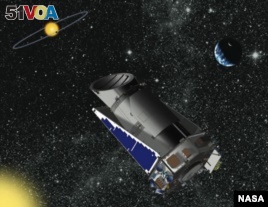August 16,2013
NASA is ending its attempts to restore the Kepler Space Telescope to full working order. The US space agency will now focus on analyzing the data collected over the past four years as the spacecraft searched for Earth-like planets around other stars in our galaxy.

Artist's rendering of the Kepler Space Telescope in orbit. (NASA)
Launched in 2009, Kepler’s mission was to find Earth-sized planets in or near the habitable zone, the region around a sun-like star where liquid water can exist on the surface of the planet. The mission’s principal investigator said Kepler has been spectacularly successful.
“At the beginning of the mission, no one knew whether Earth-sized planets were abundant or rare in our galaxy. Now at the completion of the Kepler observations, we know that our galaxy is filled to the brim with planets," William Borucki said. "It’s likely when you look up at the sky at night and see the sky covered with stars, most of the stars have planets.
Kepler discovered 135 planets and over 3,500 planet candidates with a wide range of sizes and orbital distances. Most of these planets are small, like the Earth.

Cluster of stars in Kepler's sight. (NASA)
“The wheels are sufficiently damaged that they cannot sustain spacecraft pointing control for any extended period of time,” said Sobeck.
With its observational capability compromised, the Kepler team is looking into whether the space telescope can conduct a different type of mission, potentially including an exoplanet search, using the two operational reaction wheels and thrusters. NASA has called on the science community for ideas.
“They are not proposals. They are not asking for funds," Borucki said. "They are suggesting ideas and we look at them [and ask], 'Which of these would be practical? Which of these could we do at a reasonable cost?'”
Kepler’s scientific mission is not over. The scientific team is now focusing on data collected by the spacecraft over the past four years, which Borucki expects will yield hundreds if not thousands of new discoveries.
“And so basically in the next few years when we complete this analysis we will be able to answer the questions that inspired the Kepler mission: Are Earths common or rare in our galaxy?” he said.
Borucki sees Kepler’s journey is a “critical first step in the exploration of our galaxy.” NASA is scheduled to launch a follow-up mission to Kepler in 2017. The Transiting Exoplanet Survey Satellite (TESS) will look for larger, brighter planets closer to our solar system than Kepler did.